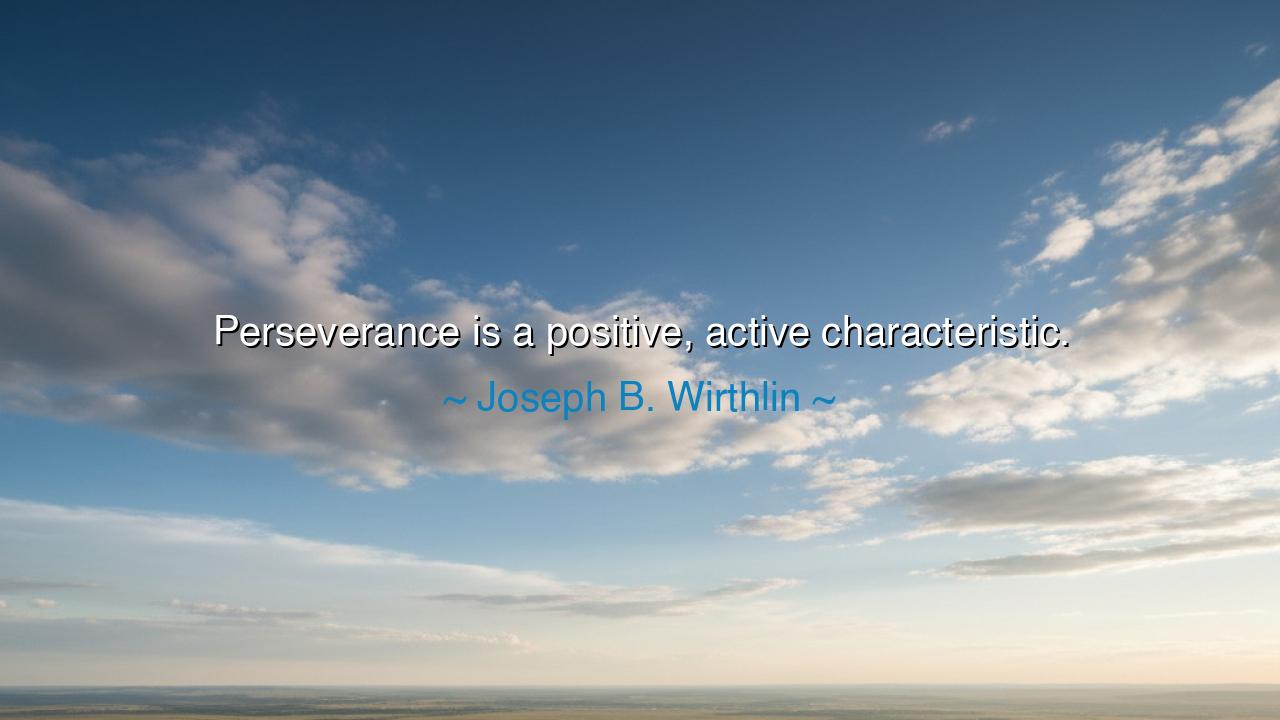
Perseverance is a positive, active characteristic.






Hear the words of Joseph B. Wirthlin, spoken with the weight of eternal truth: “Perseverance is a positive, active characteristic.” These are not light words meant for comfort alone, but a declaration of how greatness is forged. For perseverance is not passive waiting, nor idle endurance—it is a fire of the will, a forward movement through hardship, a choice renewed with every step to continue, no matter the resistance. It is positive because it builds rather than destroys, and it is active because it demands effort, not resignation.
To understand this, we must see that many confuse perseverance with mere survival. To survive is to endure until the storm passes, but to persevere is to walk through the storm with purpose, refusing to be paralyzed by its fury. It is not the stillness of the rock alone, but the steady climb of the mountaineer who pushes upward despite the wind. Thus Wirthlin names it rightly: an active characteristic, a virtue that engages the whole being—mind, body, and spirit—in the struggle for what is good.
The ancients, too, praised this quality. The Stoics taught that fortune would strike with cruelty, but the wise man’s duty was not to despair, but to continue steadfastly in virtue. Epictetus, once a slave, declared that even in chains, his soul remained free because he did not yield to bitterness. His perseverance was not idle; it was the continual choice to remain faithful to truth and discipline, even when the world gave him every reason to surrender.
History also bears witness to this truth. Consider the life of Thomas Edison, who faced thousands of failed attempts before creating the electric light. To the world, his repeated failures might have seemed like defeat. Yet his response was: “I have not failed. I’ve just found 10,000 ways that won’t work.” This is the essence of Wirthlin’s saying—perseverance not as waiting for luck, but as active engagement, as relentless motion forward until the desired vision becomes reality. Edison’s light did not come by chance; it came by will.
But Wirthlin also reminds us that perseverance is positive. It is not the stubborn clinging to destruction, nor the prideful refusal to yield when wisdom demands a change of course. True perseverance is directed toward growth, goodness, and creation. It is the strength of the farmer who continues to sow even after drought, believing the rains will return. It is the faith of the reformer who labors for justice though mocked and opposed, knowing that truth will one day prevail.
The lesson for us is clear: to live without perseverance is to fall at the first obstacle, to abandon the summit for the comfort of the valley. But to live with perseverance is to embrace the struggle as the very forge of character. Every trial becomes an opportunity to act, to grow, to keep moving forward. And each step taken in perseverance plants seeds of hope, not only for oneself, but for all who witness the struggle.
Practical actions flow from this wisdom. When you meet failure, do not see it as an end, but as instruction—an invitation to act again with greater knowledge. Train your mind daily to resist discouragement, whether through meditation, prayer, or reflection. Set small goals and meet them, building your strength step by step, until the habit of perseverance becomes part of your very nature. And encourage others in their struggles, for in reminding them to continue, you strengthen your own resolve.
So remember Wirthlin’s counsel: “Perseverance is a positive, active characteristic.” Take it into your heart as a guiding star. Do not wait idly for fortune, nor yield to despair when storms rage. Instead, walk forward with steady steps, lifting your spirit with hope, shaping your destiny with action. For those who persevere, no mountain is too high, no night too long, and no dream beyond reach.






UGUser Google
This quote prompts reflection on the connection between action and mindset. If perseverance is active and positive, how does one practice it intentionally in everyday life? Are there techniques, like incremental goal achievement, visualization, or self-reward systems, that reinforce this characteristic? I’m also curious about how perseverance interacts with motivation and optimism, and whether its benefits are primarily personal or if they also influence team dynamics and collective success.
I find this statement inspiring but it makes me consider its broader implications. How does perseverance manifest differently across cultural, professional, or personal contexts? Can perseverance be taught as a skill, or is it primarily demonstrated through lived experience? I’d like to explore whether recognizing perseverance as an active force encourages people to take initiative and remain engaged in long-term challenges, rather than passively enduring difficulties.
TTMinh Thuan Tran
This perspective raises questions about the role of mindset in cultivating perseverance. Is seeing it as a positive, active characteristic enough to strengthen it, or do external challenges and experiences play a bigger role? I also wonder how societal values, support networks, or mentorship influence the development of perseverance and whether it can be intentionally nurtured from a young age to improve outcomes in various aspects of life.
NDPhuong Linh Nguyen Do
Reading this, I feel motivated but also curious about the balance between perseverance and knowing when to pivot. Can relentless persistence ever become counterproductive if it prevents reassessment or adaptation? I’m interested in discussing how one distinguishes productive perseverance from stubbornness, and whether this active characteristic is enhanced through goal-setting, reflection, or feedback.
MY44. Huynh Thi My Y
This makes me reflect on the nature of perseverance as more than just endurance; it’s portrayed as an active, positive force. I wonder how consciously cultivating this trait can influence both personal growth and professional success. Are there specific strategies, habits, or mindsets that enhance perseverance, or is it largely innate? I’d like to explore whether perseverance interacts with other qualities, like optimism or resilience, to create sustained achievement.